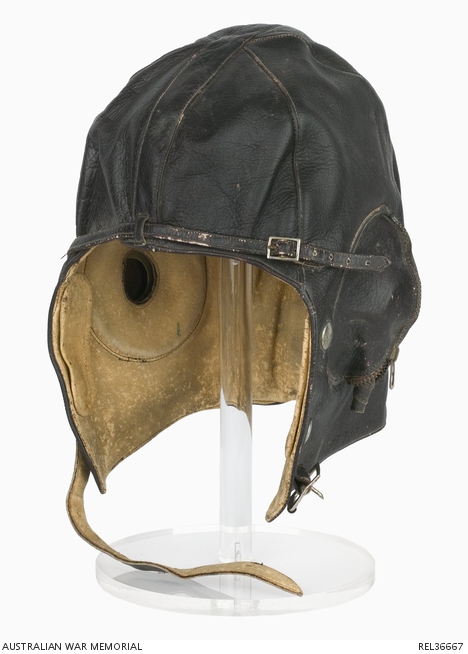| Places | |
|---|---|
| Accession Number | REL36667 |
| Collection type | Heraldry |
| Object type | Personal Equipment |
| Physical description | Brass, Chamois, Leather, White metal |
| Maker |
Lasica's Australia |
| Place made | Australia |
| Date made | c 1941 |
| Conflict |
Second World War, 1939-1945 |
Type B flying helmet : Flight Lieutenant D Rees, 460 Squadron, RAAF

Type B flying helmet made of dark brown leather and lined with chamois. There is a leather chin strap fastened on the left with a white metal buckle. On the inside of the helmet on either side of the face are two snap fasteners with a strip of chamois backed webbing fastened between them for securing an oxygen mask or face protector. There is a buckled strap across the back of the neck with two thinner buckled straps running vertically above it. Another thin buckled strap is secured across the front of the helmet. A circular ear piece is sewn on either side of the helmet with a zippered opening. Inside each piece is a brass fitting for attaching gosport tubes. A maker's label sewn inside the crown of the helmet reads ' Lasica's AUSTRALIA 7 1/4'.
Daniel Rees was born in Maylands, Western Australia on 5 February 1922. He enlisted in the Royal Australian Air Force on 21 July 1941 and was given the service number O51515. He trained under the Empire Air Training Scheme, graduating as a Sergeant Pilot. In June 1942 he was posted to the United Kingdom where he trained on Wellingtons and Lancasters before joining 460 Squadron at Binbrook. On 12 August 1943 Rees piloted a Lancaster during a raid on Milan, withstanding severe engine failure to complete the mission and return the bomber and his crew to safety. The same month, during a raid on Peenemunde, his bomber was badly damaged by fighter attack. However, Rees was once again able to return to base. For these actions he was awarded the Conspicuous Gallantry Medal which he received from King George V in a ceremony at Buckingham Palace on 14 March 1944. He was later promoted to Pilot Officer and then Flight Lieutenant. He spent time during the remainder of the war instructing on Wellingtons and Lancasters, returning to Australia in January 1945. He then served in North-Western Western Australia flying transport aircraft and in 1946 served as Air Transport and Movement Officer in Iwakuni, Japan before his discharge from the RAAF on 31 October 1947. He returned to his pre-war civilian occupation as Clerk of Courts with the Crown Law Department but from August 1952 also enlisted in the Air Training Corps, serving as the Flight Commander of No. 3 Flight Fremantle. He lived much of his post-war life at Mandurah, WA and died on 21 June 2004.
Related information
Conflicts
Subjects
Related Objects
- Conspicuous Gallantry Medal : Flight Sergeant Daniel Rees, 460 Squadron, RAAF
- 1939-45 Star : Flight Lieutenant D Rees, 460 Squadron, RAAF
- Air Crew Europe Star : Flight Lieutenant D Rees, 460 Squadron, RAAF
- Defence Medal : Flight Lieutenant D Rees, 460 Squadron, RAAF
- British War Medal 1939-45 : Flight Lieutenant D Rees, RAAF
- Australia Service Medal : Flight Lieutenant D Rees, RAAF
- Cadet Forces Medal : Wing Commander D Rees, RAAF Air Training Corps
- Reserve Force Medal : Wing Commander D Rees, RAAF Air Training Corps
- Bomber Command Tribute Medal : D Rees
- Pair of gloves : Flight Lieutenant D Rees, 460 Squadron, RAAF